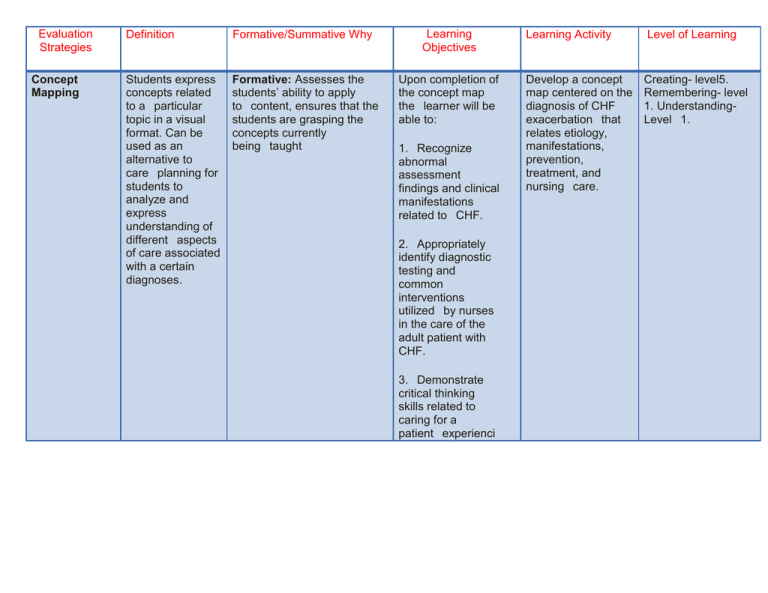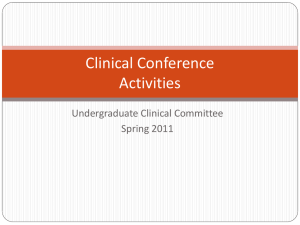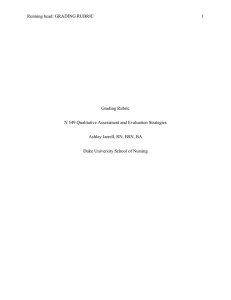Evaluation Strategies Definition Formative/Summative Why Learning
advertisement

Evaluation Strategies Concept Mapping Definition Formative/Summative Why Learning Objectives Students express concepts related to a particular topic in a visual format. Can be used as an alternative to care planning for students to analyze and express understanding of different aspects of care associated with a certain diagnoses. Formative: Assesses the students’ ability to apply to content, ensures that the students are grasping the concepts currently being taught Upon completion of the concept map the learner will be able to: 1. Recognize abnormal assessment findings and clinical manifestations related to CHF. 2. Appropriately identify diagnostic testing and common interventions utilized by nurses in the care of the adult patient with CHF. 3. Demonstrate critical thinking skills related to caring for a patient experienci Learning Activity Level of Learning Develop a concept map centered on the diagnosis of CHF exacerbation that relates etiology, manifestations, prevention, treatment, and nursing care. Creating- level5. Remembering- level 1. UnderstandingLevel 1. ng a CHF exacerbation. Grading Rubric A grading rubric is a practical tool that provides a description of an assignment with a breakdown of the parts of the assignment. Each of the identified parts is scored for the purpose of evaluation. The grading rubric is used to evaluate student s’ development, facilitates self and peer evaluation and promotes deeper learning among nursing students. It provides the students with a concrete view Summative: Evaluates competence and ensure students have acquired the information given (Billings, & Halstead, 2012). Formative: Provides students with quick and quality feedbacks to improve their performance (Billings, & Halstead, 2012). Upon completion of the Adult Patient with Congestive Heart Failure (CHF) Module, the students will be able to: 1. Describe the signs/symptoms of CHF. 2. Summarize Pathophysiology ofCHF. 3. Develop a nursing care plan that includes nursing diagnoses, goals, and nursing interventions for a patient with CHF. 4. Compare and contrast the diagnostic tests for CHF. 5. Determine the differences between the Right-Sided Heart Failure and Left-Sided Heart Failure in the 1. Pre-class reading assignment. 2. In-class learning activities: case study, group discussions 3. Post-class learning activities: online discussion, CHF Final Paper. (Cognitive Domain) Remembering- Level 1. Understandinglevel 2. Analyzing- level 4. Creating- level 5. of their performance and allows them to make changes to improve their performance early in the class. Rubrics provide a clear communication of the expectations for the students and the educators (Billings, & Halstead, 2012). Presentation Delivering a speech to the class to provide them with new content knowledge on a specific topic. adult patients. Formative: Assesses how well the student understands a particular topic they have just learned about; allows the instructor to evaluate if further clarification is needed Upon completion of the presentation students will be able to: 1. Explain the pathophysiology of the assigned illness. Develop a presentation on the assigned illness experienced by the adult patient to present to the class including clinical manifestations, etio logy, treatment, nursing Creating- level 5. Remembering-level1. Understanding- level 2. Explaining. Tests Tests are used at a particular periods of time in a course to measure student’ s progress as part of the grading process as well as determine what students do or do not learn about a certain topic. Tests include different types of question such as short answer questions, true Summative: Provides the educators and students with feedback about students’ achievement as well as allows educator to change his/her teaching strategies if needed. Tests are a great strategy to assess students understanding and evaluate students’ progress in the course (Billings, & Halstead, 2012). 2. List clinical manifestations of the assigned illness 3. Explain the etiology, manifestations, prevention, treatment, and nursing care associated with the assigned illness. interventions, and prevention. Upon completion of the of the Medication Safety Module, the student will be able to: 1. Identify high alert medications. 2. Compare and contrast medications used for controlling pain. 3. Analyze safety risks for medication administration. 4. Identify patient safety with the uses of different medications used for 1. Pre-class reading assignment. 2. In-class learning activities. 3. Lectures. (Cognitive Domain). Remembering- Level 1. Understandinglevel 2. Analyzing- level 4. and false, and multiple choices. controlling pain. . Simulation Simulation is the use of manikins, equipment, and live-action roleplay to represent clinical situations (Billings & Halstead, 2012). Summative and Formative: Simulation is a way to evaluate the students’ accomplishment of course goals and objectives (Herrman, 2016). It also gives feedback to the instructor and allows the instructor to assess learning in order to improve teaching strategies (Herrman, 2016). Upon completion of the simulation the student will be able to: 1. Identify symptoms critical to medical diagnoses presented. Pre-class reading assignment. Case study presentation. Student demonstration. Post simulation review. Domain: Psychomotor and cognitive domains. Level 1: Remembering. Level 3: Applying Level 3: Applying. 2.Demonstrate a comprehensive assessment the patient with correct technique 3. Apply the nursing process to a particular patient situation. Journal Entry Communicates Can be formative or Define your Reflective Journ Analyze- level 4. Grading Rubric to the students what is expected and provides clear guidelines and consistency among faculty for grading. Placing higher value or points in certain areas will encourage stu dents to focus to achieve. summative. Formatively shows that integrative learning is occurring and demonstrated as class concepts are presented. Shows concepts being applied or internalized. Allows the student to self-assess for insight and self-awareness. Provides continuous feedback. Summatively can show the outcomes overall. own conflict resolution style and inventory other useful methods for when and where to apply. aling om Conflict Management and Resolution. Evaluate-level 5. Apply-level 3. Participation Grading Rubric Informs student that participation is expected and counts as part of grade. Encourages active discourse. Formative for continuous feedback. Comments made by students reflect that preclass reading was completed and the moving video reinforcement of concepts Define and articulate the principles of leadership and compare and contrast with management principles used in nursing Moving video on Leadership followed by class discussion with leading questions Rememberlevel1. Analyzelevel 4.





